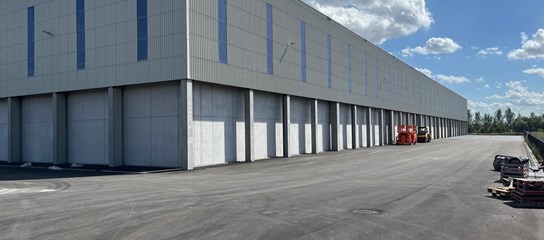New Lock in Terneuzen provides economic boost and bigger ships for North Sea Port
The opening of the New Lock in Terneuzen is not an end point but the start of the next stage in the economic development of the cross-border North Sea Port area. The economic importance and future of one of the biggest locks in Europe and the world cannot be underestimated. After all, the New Lock will be extremely significant for maritime and inland navigation, for the growth of existing businesses and the arrival of new investors to our multimodal port – in short, for the economic development of the Netherlands, Belgium, Flanders and the port area.
As Europe's ninth-biggest port, North Sea Port occupies a prominent position in European and global shipping traffic. The New Lock further enhances that position since it will henceforth form part of two European transport corridors on which North Sea Port is located: the North Sea-Baltic corridor and the North Sea-Rhine-Mediterranean corridor.
Second, larger sea lock guarantees supplies to businesses
With the New Lock, North Sea Port not only has a second sea lock but also a larger one, through which larger seagoing vessels can sail from the North Sea towards Terneuzen and Ghent. Ships can be up to 100 metres longer (up to 366 metres) and a third wider (up to 49 metres). And that is quite an advantage, since those larger ships – the so-called Neo/postpanamax vessels – have become increasingly important for international trade and shipping routes over the past twenty years.
This second sea lock, located next to the West Lock for maritime navigation, will also allow North Sea Port to guarantee permanent maritime access to the port area beyond the lock. This means an alternative will be available during maintenance on a sea lock, for example, assuring supplies to businesses at all times.
Faster transit through lock complex for barges
North Sea Port is a crucial hub for inland navigation in Europe and has direct connections by water in every direction. Which is useful for inland barges wishing to sail from Ghent and Terneuzen to the Western Scheldt and beyond to the Netherlands and Germany, or vice versa up to 32 kilometres inland (i.e. as far as Ghent), or to northern France.
The New Lock increases the capacity of the North Sea locks at Terneuzen, which include the West Lock and the East Lock for inland navigation – allowing more barges to pass through the locks at the same time and significantly reducing waiting times. Representing a huge capacity boost for transport via inland waterways. Over 60% of all transport between the port and the hinterland is already provided by inland shipping.
Lower costs and more jobs
The bigger ships that can pass through the New Lock carry more cargo. That means lower costs for businesses, making expansion of existing businesses and new investments more attractive. And that in turn offers room for economic growth for both the Netherlands and Flanders, with new employment and development opportunities in the Canal Zone for Terneuzen and Ghent.
Future Seine-Scheldt connection
As a gateway to Terneuzen and Ghent, the North Sea locks, including the New Lock, are a crucial link in the future Seine-Scheldt connection. The development of this European inland navigation link between the Seine and Scheldt basins will allow larger barges to sail even deeper into France from North Sea Port in the future – as far as the Paris conurbation, with a population approaching 10 million.
Cooperation between the Netherlands and Flanders
The New Lock has been described as the crowning glory of the merged port. Since 1 January 2018, the former Dutch Zeeland Seaports (Vlissingen and Terneuzen) and the port of Ghent have been merged as North Sea Port. Our 60-kilometre-long cross-border port area, which provides 106,000 jobs, is a recent result of cooperation between the Netherlands and Flanders that goes back centuries.
Committed to bigger vessels on the Ghent-Terneuzen Canal
The port authority, North Sea Port, and the companies that use the New Lock and those bigger seagoing vessels, or will in future, are keen to celebrate that cooperation, and to extend it in the future in order to enable larger ships from the New Lock to reach Terneuzen and Ghent within a few years. The first steps to that end have already been taken.
Trials with ships up to 37 metres wide have been taking place in the weeks before and after the opening of the New Lock. These will enable to partners in the nautical chain, such as traffic controllers, pilots and towing services to 'get to grips' with the operation of the New Lock in practice. Subsequently, trials with wider vessels between 38.5 metres and 40 or even 42.5 metres wide are planned for 2025.
First Terneuzen, then Ghent
North Sea Port makes no secret of the fact that it very much wants to see, in the near future, a deeper canal that can accommodate vessels with a draught of up to 14.5 metres, right up to the bulk cargo port in Terneuzen. That is the first kilometre beyond the lock, and deepening it is technically feasible in the short term. Ocean-going vessels would then no longer need to offload cargo on the Western Scheldt in order to reduce their draught before passing through the New Lock, but instead could do so more safely and cheaply at the port.
The port authority also looks forward to 43-metre-wide vessels sailing from the New Lock to Kluizendok and Rodenhuizedok in Ghent within about three years. For a ship of this kind carrying dry or liquid bulk, that would mean several hundreds of thousands of euros in cost savings.
Future steps to optimise the accessibility of the canal obviously need to take full account of local residents and the surrounding area.
The end point of seven years of construction, the New Lock, at once marks the beginning of the further economic development of the Dutch-Flemish cross-border port area of North Sea Port.



